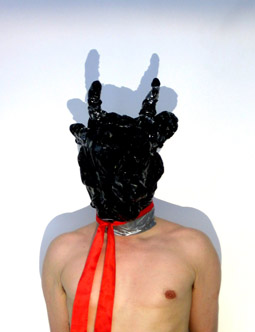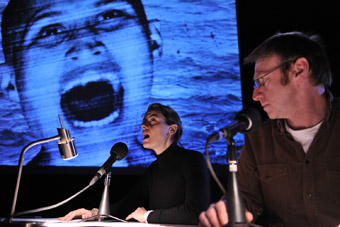 |
A Forest, Pacitti Company photo courtesy Pacitti Company |
This is one of the dark fairy tales told in Pacitti Company’s A Forest, an intimate performance for a small audience gathered around a gleaming mound of coins. Three performers cohabit the space: Robert Pacitti telling stories from the circle’s periphery; Sheila Ghelani serving as hostess, an intermediary between audience and event; and Richard Eton as the stooge, the fall guy, his body a canvas for Ghelani’s manipulations. She circles the space coyly, offering first her breasts and later a pair of pig’s feet. Eton burrows into the coins, dances to exhaustion and finally becomes a landscape of small trees, affixed with hot wax to the contours of his supine body. Pacitti tells story after story in a carefully modulated tone that is both demure and gleeful, taunting us to join in an indulgence of depravity and refusal. It feels as if the work itself wants to be like that hole in culture, the one blown open by the ravens; it wants to transform the pile of money we are staring at into an empty void, capitalism’s hollow heart. This is a deliberately audacious piece of theatre, and its success depends on each individual audience member choosing to go along with it. But then this is spelled out at the very beginning. Pacitti says, “You have two choices: believe everything is okay, or drown in shit.”
Pacitti is also the founder and curator of the biennial SPILL Festival, now in its second instalment. Just as he intends A Forest to be an interruption within culture, the works he has selected for the festival also feel like irruptions of culture’s dark side. Julia Bardsley’s Aftermaths: A Tear in the Meat of Vision draws an extended and multi-textured analogy between the current crisis of capitalism and ideas of religious rapture and apocalypse. Bardsley appears on a cross-shaped catwalk as part space cowboy, part revivalist preacher, her teeth gleaming with diamonds and a horsehair tail trailing behind her. The audience stands in four inwardly facing sections, divided by the catwalk and surrounded on the outside by large video projections.
Capitalism can be a soft target, especially when it’s already down, but Aftermaths digs below the surface to expose primal fears and desires, a craving for accumulation which hopes desperately to forestall annihilation. “Welcome to the black market”, Bardsley declares, “I will be the eye by which you see the sight of things hidden.” Her visuals and immersive sound experience are striking, and the glossy, black catwalk a powerful theatrical statement. But despite being surrounded on all sides by fleshy, visceral images, and despite the dance-club feeling of the throbbing soundtrack, the experience still feels distant; the piece remains too theatrically self-conscious to be totally immersive. Maybe this makes sense: rather than replacing the spectacle of capitalism with the spectacle of anti-capitalism, Bardsley leaves her viewers questioning, free to choose, as individuals rather than members of a congregation of converts.
In keeping with the festival’s commitment to audience engagement, at its centre was an unprecedented mashup of art, counterculture and politics: the 12-hour, dusk-till-dawn Visions of Excess. This swirling mix of provocations and performances included Bruce Labruce’s troupe of blue-eyed, (fake) blood-drenched, masturbating zombies; Ron Athey’s wig-wearing, (real) blood-soaked self-fisting; Samantha Sweeting’s one-to-one breast-feeding encounter; and host David Hoyle’s sharp-tongued mix of universal bonhomie with strident class and gender militancy. Visions of Excess admirably expands the frame of the art festival and the kinds of work to which it lends legitimacy. But this expanding frame also overlaps with others. An unsettling coincidence was the fact that Visions’ venue (the Shunt arches under London Bridge station) placed it next door to the London Dungeon attraction, with its own less transgressive deployment of blood-soaked zombies. Inside the event, the atmosphere and audience shared much with London’s club scene, bringing its own celebratory sense of community, but also its hierarchies and exclusions. And throughout the evening, I often found myself twice-removed from the events, being unable to directly see what was happening and instead looking through a glowing swarm of digital camera displays. Overall, the event produced a complicated, shifting blend of different forms of community: we were sometimes consumers, sometimes voyeurs, sometimes engulfed within a collective, and sometimes singled out as intimate partners.
For me, the works which were most effective in this context of expanding and overlapping frames were those which attended to their circumstances, creating or commenting upon their own framing. In Zackary Drucker’s interactive performance, crowded onlookers, hungry for spectacle, were twisted into unwitting accomplices. Pushing forward to try to glimpse his reclining, hermaphroditically posed body, we were invited to help ‘perfect’ the image by plucking all the hairs from his body with individual tweezers. And Franko B’s I’m Thinking of You featured first Franko and then a series of volunteers each sitting naked on a gilded swing for an hour. The idyllic, beautifully lit scene was a point of constancy through the evening. Amidst an orgy of complex images, mesmerising, unsettling, innocent and provocative, its simplicity worked its way subtly under the skin.
 |
Cathy Naden, Richard Lowdon, Void Story, Forced Entertainment photo photo Hugo Glendinning |
And yet, despite everything, I start to feel something for these two characters. When one has his leg caught in a bear trap, the sound of breaking bone is only electronic crackling, and the projected image is just a picture of a trap pasted onto a photo of an actor, and the howling actor is not feeling any pain; and yet my stomach turns anyway. This discomfort is part of a wider pleasure, which is the reality of being told a story. It’s like something the narrator says in Tim Etchells’ 2008 novel, The Broken World, which describes an immense and unending computer game. Rejecting those who question the reality of the game, he asks, “Is it reality to be even asking if it’s reality in the first place?...In the end The BW is just a part of reality. It is in the world—a part of the world. That’s all there is to say.”
The final theatre piece of the festival is another Pacitti Company work, Intermission, a mesmerising solo performance by Sheila Ghelani. Ghelani alternates between nine microphones, each labelled with a mode of performance: fact, fiction, high horse, karaoke... The piece appears to set itself up as the chance to tell it like it is, once and for all, on a series of controversial topics: abortion, death, religion, cannibalism. But as Ghelani shifts between topics and modes of address, what emerges is less a strident, coherent manifesto and, more interestingly, a complicated overlap of different voices and contradictory beliefs. As with the storytelling in A Forest or Void Story, as with the theatricality of Aftermaths, and as with the overlapping audiences in Visions of Excess, Intermission foregrounds the fact that there is no place outside culture from which to stage an intervention. Any intervention into the way things are will always be made out of things that already are—readers, actors, witnesses, places—just twisted, made strange, spilling out of their boundaries.
Pacitti Company, A Forest, conceived and directed by Robert Pacitti, co-devised and performed by Richard Eton, Shelia Ghelani, Robert Pacitti, music Sebastian Castagna; The Pit, Barbican Theatre, April 7-9; Pacitti Company, Intermission, made by Robert Pacitti and Sheila Ghelani, performer Sheila Ghelani; Soho Theatre, April 22-24; Julia Bardsley, Aftermaths: A Tear in the Meat of Vision, created and performed by Julia Bardsley, music Andrew Poppy; Laban Centre, April 13-18; Forced Entertainment, Void Story, Soho Theatre, April 21-25; Visions of Excess, curators Ron Athey, Lee Adams; Shunt Vaults, April 12
RealTime issue #91 June-July 2009 pg. 4
© Theron Schmidt; for permission to reproduce apply to [email protected]








 back
back